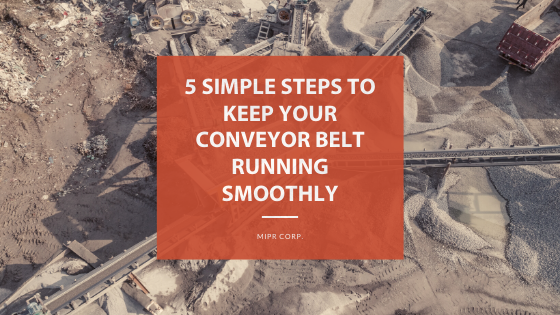
Is your conveyor belt slipping? Do you see uneven wear and tear or parts failures on your conveyor system? Are frequent (and inconvenient) work slowdowns and stoppages costing you time and money, or putting your employee safety at risk?
At MIPR Corp., many of our customers first come to us for belt service or replacement. We have built a nationwide reputation on our ability to expertly diagnose problems over the phone and ship effective solution same-day. Yet our engineers know that the fastest, most cost-effective fix for conveyor belt problems is prevention. Conveyor preventative maintenance can make all the difference!
1. INSTALL THE RIGHT BELT THE RIGHT WAY
No conveyor belt supply companies carries the wide range of belt types we do, and our extensive catalog gives our team an edge when customers call in with unique conveyor maintenance We know when to recommend a modular plastic belt over a metal mesh belt, which cleat design and arrangement will best carry your products or materials, how to handle curves and inclines, and more. If a conveyor belt on your production line is constantly giving your team fits, it may not be the right fit for the job—or it may fit poorly with the frame, motor, rollers, or alignment of your line.
You might need a different belt, a lower or higher incline, cleats or sidewalls, or a stronger motor. The fastest way to find out the quickest fix? Talk to the MIPR conveyor belting team. We have over 40 years of proven experience picking the perfect belt and putting you in a position to succeed. Our engineers are always standing by to talk to you about a possible conveyor belt replacement. Before you call, read our guide to gathering the information we need to advise you on a conveyor belt replacement.
2. Keep Your Conveyor Belt Clean
Belt maintenance begins with belt cleanliness. Even small residues of oils, greases, or particulates in the nooks and crannies of a conveyor belt system can wear down a conveyor belt over time—throwing a belt out of alignment, causing slippage, or corroding materials. A thorough and regular cleaning and/or sterilization protocol can save you so much time and money down the road.
Follow your conveyor belt manufacturer’s recommended guidelines for conveyor belt maintenance so you know how to clean your conveyor belt system and the right cleaning agents to use. (Some chemicals can react with or corrode certain types of belting materials, like plastic.) Take apart your conveyor belt system for deep cleans and regular sanitization and pay close attention to corners, joints, and other places where materials or spills can collect unseen. And finally, carefully test your belt tracking post-cleaning before putting your conveyor belt back online.
Remember, trapped materials on the surface of the pulley or on the belt table is the single most urgent problem against performance and belt life.
3. Check Your Conveyor Belt Tracking
Careful conveyor belt adjustment can also prevent uneven wear-and-tear and belt slippage. Just like the tires on your car, improperly aligned conveyor belting will “pull” in one direction, stressing and wearing it down unevenly and causing it to catch or slip over time. (The narrower your conveyor belt, the more likely it is to suffer from tracking issues.) Scrape these materials off and remove them from the area.
The signs of tracking problems are similar to those you may have experienced with your vehicle tires: vibrations or grinding noises, spots of uneven wear or damage, or frequent slips and stoppages. Not sure how to keep a conveyor belt centered? Check out our in-depth guide on conveyor belt tracking for helpful tips on re-aligning your production line!
4. Watch Out For Signs Of Conveyor Belt Slippage
Conveyor maintenance can also stop your conveyor system from slipping. The initial signs of conveyor belt slippage can be subtle—so keep an eye out! Conveyor belt slippage is by far the most common conveyance maintenance problem and it can cause a whole series of additional problems—work stoppage, material loss and damage, and even employee injury. You need to stop the slide before it starts.
Tracking issues, incorrect lacing, improper tension adjustments, and worn pulleys can all contribute to a conveyor belt slip. The MIPR Corp. in-depth guide to conveyor belt slippage can show you the signs of conveyor belt slip and how to stop them.
5. Train Your Team To Tackle Conveyor Maintenance Problems In Real-Time
When employees know their equipment well and feel empowered to see and solve problems in real-time, everyone is engaged in preventing work slowdowns and stoppages, and work runs safely and smoothly. The frontline workers feeding and supervising your conveyor belting equipment will be the first ones to notice small deviations and problems—and they should also be the first ones to fix or flag them before they turn into larger issues.
MIPR Corp. recommends making sure that the staff charged with running your conveyor belt equipment be thoroughly trained in proper usage and taught to look out for any changes that might signal developing problems: strange noises, slowing or grinding or catching, uneven wear, etc. Have an established protocol in place that allows for onsite fixes and repairs by skilled staff and a reporting system for when a potential problem exceeds their expertise. And remember, MIPR Corp. engineers are always here to respond to problems and propose solutions.
We want all our customers to receive the maximum performance and value from every investment they make in their conveyor belt system. If you want additional guidance on regular maintenance, cleaning, and repairs, don’t hesitate to call the MIPR Corp. team!




